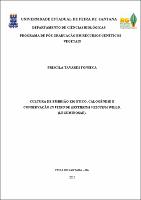| Compartilhamento |


|
Use este identificador para citar ou linkar para este item:
http://tede2.uefs.br:8080/handle/tede/1047| Tipo do documento: | Dissertação |
| Título: | Cultura de embrião zigótico, calogênise e conservação in vitro de Erythrina velutina Willd. (Leguminosae) |
| Autor: | Fonseca, Priscila Tavares  |
| Primeiro orientador: | Santana, José Raniere Ferreira de |
| Resumo: | Erythrina velutina é nativa do bioma Caatinga, apresentando relevada importância sócio-econômica e medicinal. Objetivou-se nesse trabalho o cultivo de embrião zigótico, bem como, calogênese e conservação in vitro de E. velutina. No primeiro experimento foi feito estudo comparativo da germinação entre sementes intactas e o cultivo de embrião avaliando o efeito dos reguladores vegetais BAP e ANA sobre a morfogênese in vitro. No segundo experimento verificou-se o efeito de BAP e CIN na regeneração de segmentos nodais. No terceiro experimento observou-se o efeito do 2,4-D na calogênese in vitro de diferentes explantes: embriões zigóticos inteiro e seccionado, folhas e epicótilo. Nos calos de embriões zigóticos analisou-se o crescimento cinético, quantificou-se os AR e AST e fez-se a anatomia vegetal. No último experimento avaliou-se o efeito do agente osmótico sacarose e do retardante de crescimento PBZ na conservação in vitro. Para germinação o cultivo de embriões zigóticos proporcionou plantas mais vigorosas. O explante plúmula e embriões zigóticos podem ser regenerados na concentração de 4,0µM de BAP, as regiões intermediária e radícula promoveram a formação de calos compactos na combinação de 10,63µM BAP e 2,0µM de ANA. Na regeneração in vitro a concentração de 20µM de BAP induziu maior número de brotos em segmentos nodais. Para calogênese a concentração de 11,75µM de 2,4-D induziu calos friáveis em embriões zigóticos inteiros sendo verificado a redução dos AR, AST e presença de células em divisão e amiloplastos durante o período de cultivo. A curva de crescimento mostrou que os calos devem ser transferidos para meio de subcultivo entre o 15o até o 21o dia. Na concentração testada de 11,75µM de 2,4-D obteve-se calos friáveis de segmentos foliares. Foi observado crescimento mais lento das culturas na temperatura de 18ºC, a concentração de sacarose até 175,28mM não foram suficientes para reduzir o crescimento das plantas. Quando acrescido ao meio de cultura de 4µM de BPZ nota-se redução no crescimento das plantas. |
| Abstract: | Erythrina velutina is a native Caatinga biome, with increasing socio-economic importance and medical. The objective of this work were to culture zygotic embryo, as well as in vitro E. velutina callus formation and conservation. The first experiment was a comparative study of seed germination between intact and embryo rescue evaluating the effect of plant growth regulators BAP and NAA on in vitro morphogenesis. The second experiment was verify the effect of BAP and CIN in the nodal segments regeneration. The third experiment observed the effect of 2,4-D on in vitro callus formation from different explants: zygotic embryos whole and sectioned, leaves and epicotyl. In callus cultures of zygotic embryos we analyzed the kinetics growth, quantified if the AR and AST did to plant anatomy. In the last experiment evaluated the effect of sucrose osmotic agent and the PBZ growth retardant the in vitro conservation. For germination of zygotic embryos cultivation provided more vigorous plants. The plumule explant and zygotic embryos can be regenerated at concentration of 4.0μM of BAP, the intermediate regions and the radicle promoted formation of compact callus on the combination of 10.63μM BAP and 2.0μM NAA. In regeneration in vitro concentration of 21.03μM BAP induced higher number of shoots in nodal segments. For callus formation concentration of 10.65μM 2,4-D induced friable callus on zygotic embryos whole and the reduction of AR, AST and the presence of dividing cells and amyloplasts during the growing period. The growth curve showed that callus should be transferred to subculture medium between the 15th to the 21st day. In the tested concentration of 11.75μM 2,4-D was obtained friable callus on leaf segments. We observed slower cultures growth at a temperature of 18°C, concentrations of up to 175.28mM sucrose was not sufficient to reduce plant growth. When using PBZ was observed a reduction of plant growth when added to the culture medium 4μM of BPZ. |
| Palavras-chave: | Mulungu Regeneração in vitro Citocininas Auxinas Calogênese Crescimento mínimo In vitro regeneration Cytokinin Auxin Callus formation Minimum growth |
| Área(s) do CNPq: | CIENCIAS BIOLOGICAS CIENCIAS BIOLOGICAS::BIOLOGIA GERAL |
| Idioma: | por |
| País: | Brasil |
| Instituição: | Universidade Estadual de Feira de Santana |
| Sigla da instituição: | UEFS |
| Departamento: | DEPARTAMENTO DE CIÊNCIAS BIOLÓGICAS |
| Programa: | Mestrado Acadêmico em Recursos Genéticos Vegetais |
| Citação: | FONSECA, Priscila Tavares. Cultura de embrião zigótico, calogênise e conservação in vitro de Erythrina velutina Willd. (Leguminosae). 2012. 92 f. Dissertação (Mestrado Acadêmico em Recursos Genéticos Vegetais)- Universidade Estadual de Feira de Santana, Feira de Santana, 2012. |
| Tipo de acesso: | Acesso Aberto |
| URI: | http://tede2.uefs.br:8080/handle/tede/1047 |
| Data de defesa: | 27-Fev-2012 |
| Aparece nas coleções: | Coleção UEFS |
Arquivos associados a este item:
| Arquivo | Descrição | Tamanho | Formato | |
|---|---|---|---|---|
| Dissertação_Priscila Tavares.pdf | Arquivo em texto completo. | 3,09 MB | Adobe PDF |  Baixar/Abrir Pré-Visualizar |
Os itens no repositório estão protegidos por copyright, com todos os direitos reservados, salvo quando é indicado o contrário.




